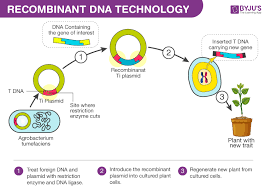What is the Primary Intent of Recombinant DNA Technology?
Recombinant DNA technology involves inserting genes into a carrier (vector) that then carries the gene of interest into a cell. The gene is then replicated during cell division. It is not possible to introduce the gene of interest directly into a cell since the cell may view it as foreign material. This is where the role of the vector is crucial. The carrier may be a plasmid or another type of DNA molecule.
uses
Recombinant DNA technology is a process in which scientists combine DNA molecules from two different species to produce a new type of DNA. Usually, these molecules come from bacteria or viruses. When recombined, they produce multiple copies of the desired DNA. This method has many uses, including vaccine production and genetically engineered crops.
One of the most common uses of recombinant DNA technology is for diagnostic purposes. Recombinant DNA technology has helped scientists develop a gene that can test for human genetic diseases, and it is currently being used in diagnostic testing. It also makes it possible to create recombinant vaccines for a variety of diseases.
However, the use of recombinant DNA technology is a controversial topic. Proponents argue that research involving recombinant DNA should be free of commercial interests. Others point to ethical concerns regarding the misuse of publicly-funded research. This issue has led some self-righteous proponents of the technology to distance themselves from mainstream scientists and embarrassment. This, in turn, shifted some of the forces of the debate to the legislative arena.
Other uses of recombinant DNA technology include the development of drought and heat-resistant crops. For example, recombinant genes have made it possible to produce insulin in larger quantities. Recombinant DNA technology also allows scientists to produce antibiotics and human protein replacements.
Another common use of recombinant DNA technology involves the development of enzymes. These enzymes are made from bacteria and act by hydrolyzing specific sequences of DNA molecules. This technology also helps scientists create new vaccines. This technology is crucial for improving human health.
In addition to being a versatile gene-expression tool, recombinant DNA technology is also widely used to create libraries of genes expressed in various organisms. By creating cDNA libraries, researchers can analyze and study the genes that are expressed in an organism. They can then use this information to develop vaccines and other products.
Another use for recombinant DNA technology is to enhance the production of human antibodies. A cloned gene has the ability to replicate thousands of times in the same organism. This technique also provides the potential to create clones with specific features, such as resistance to antibiotics.
regulation
Recombinant DNA technology was first developed in the 1970s in the United States. In 1975, leading scientists from around the world met at the Asilomar Conference to discuss the risks and potential repercussions of the technology. In 1976, the U.S. National Institutes of Health published Recombinant DNA Research Guidelines. While these guidelines have impacted many nations, few historical studies have focused on recombinant technology in Japan. To that end, the purpose of this paper is to discuss the recombinant technology in Japan.
The unfounded concerns regarding recombinant DNA technology have led to a series of government initiatives aimed at regulating the technology. These programs aim to regulate recombinant DNA-modified organisms in various applications, including medicine and agriculture. Regulators will likely repeat the oversight mistakes of recombinant DNA technology in synthetic biology, a science that involves designing and building new biological components, systems, and devices.
The RAC’s role in shaping the guidelines for rDNA research began in 1969 when gene splicing experiments began. In 1971 and 1975, companies such as Cetus and Genentech were formed to further this research. In the US, the moratorium on recombinant DNA technology ended in 1975, after discussions over regulation.
Despite these concerns, these meetings ultimately led to the formation of the Recombinant DNA Molecule Advisory Committee. It was the first step toward regulating the technology. Regulators must make sure that recombinant DNA experiments are conducted in a safe environment for workers.
Recent developments in this technology have made it easier to develop new drugs and other medical products. These breakthroughs are crucial to the advancement of science. And they are becoming increasingly common. There are several applications for recombinant DNA technology in plant breeding, food production, and environmental fields. But these advances have also raised concerns about the hypothetical repercussions of these technologies.
The EPA has begun to regulate “new” organisms created through genetic engineering. “New” organisms are defined as those with DNA from different sources. They include organisms that eat oil spills. The EPA sees “newness” as synonymous with risk. The EPA also believes that these genetically altered organisms are among the biggest risks to the environment and people.
controversy
The controversy surrounding recombinant DNA technology isn’t new. In fact, it was long-contained within the world of molecular biologists. Some, however, are questioning the ethics of the new technology. Critics contend that it disrupts the natural order and manipulates DNA.
The Asilomar conference was a pivotal moment in the recombinant DNA technology controversy. Many scientists had already called for the creation of a safety protocol, and the conference was intended to develop consensus on interim guidelines. But the overwhelming public response and widespread mistrust surprised the scientists. As a result, the debate over the safety of the new technology continues.
Recombinant DNA technology is the latest advance in molecular biology. It began when scientists discovered how to use restriction enzymes to cut DNA. The resulting linear segments of DNA have sticky ends that can be spliced together to form hybrid DNA. This hybrid DNA is then inserted into bacteria and viruses and changes their DNA.
